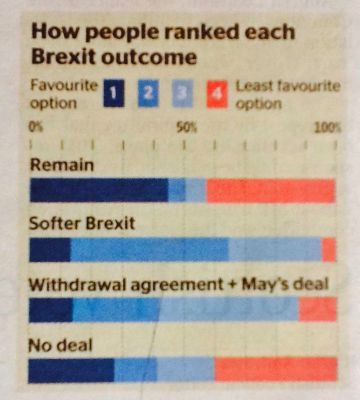Most To Least Favoured Political Mapping

I spent much of the weekend this chart appeared in The Times print edition (Sat 27 Apr 2019) obsessing over the graphic.
Not necessarily the topic whence it hails.
More, the implications for solution selling.
I’ve brightened my original photo colours somewhat. They show starkly what might well happen should the fairly popular ‘transferable vote’ system hold sway. In this case, the option with the least number of people wanting it above all else, becomes the winner by dint of a then combined majority when transferring those putting it as their second-preference.
Democracy?
Sounds like many a corporate purchasing decision. Especially remembering the far too frequent revanchists (tellingly, from the French word for revenge) I’ve encountered who put all their energies into reversing a decision that they feel they cannot actually “live with” or they perceived as snubs them in some fashion.
The similarities with b2b buying ought be explored here.
It is not uncommon for a major purchase to also have four options. For instance;
a shortlist of two, perhaps an internal third way, and the spectre of the status quo when doing nothing prevails.
If there’s no overall, binary winner, then how is the choice made?
Decision making units can have multiple components. Particularly if you end up in a full Boardroom forum. Half-dozen or more can have – or worse, need to be seen to have – influence. Irrespective of any relevance to their daily work routines or functional expertise.
How do you test the waters before the selecting vote?
A perilous undertaking. Subterfuge, distraction, silence. They can all hamper uncovering true positions.
Knowing each judge’s favourite, and for that matter least favourite, option may not, with sufficient, reliable internal help, be all that difficult. Although naturally, still delicate and fraught.
Yet identifying overall ranking, one which isolates preferences two and three, now, that is tough.
Unless there’s a dutch auction, price-buster or makeweight situation, execs are familiar with each shortlisted candidate being able to do the job. This would be especially important in the case where the second-most backed across the board – as described earlier – can come through the field.
And don’t think this doesn’t happen. The more people allowed a say for whom your sale is relatively inconsequential, the more likely this is to be the case. Then there’s always the infamous voting procedures for massive international sporting bonanzas. Both the Olympics (at least ever since Sydney upset Athens for 2000) and Football World Cup are renowned for being awarded to the host that garners most second choice votes.
Where you’ve the heady mix of manageable number of voters with limited possibilities open, can you form your own grid of rankings by each person per alternative?
Then how you react to this, well, that’s a whole new science…
